Lessons in herbal tea blending: How to use hard roots and berries in an infusion to hold space
I love it when a tea inspires. And I love it when the berries, roots, seeds and barks of a tea reveal their taste and medicine with each step. In this post I am going to talk about another lesson in herbal tea blending: how to use hard roots and berried in an infusion to hold space.
As an example I am sharing a Cedar, Rose and Rosemary herbal tea formula is a mentally uplifting blend. Not only is it rich in the antioxidant polyphenol rosemarinic acid (which assists mental clarity) it is also balanced within the digestive system and rooted in the Kidney-Adrenal system, too.
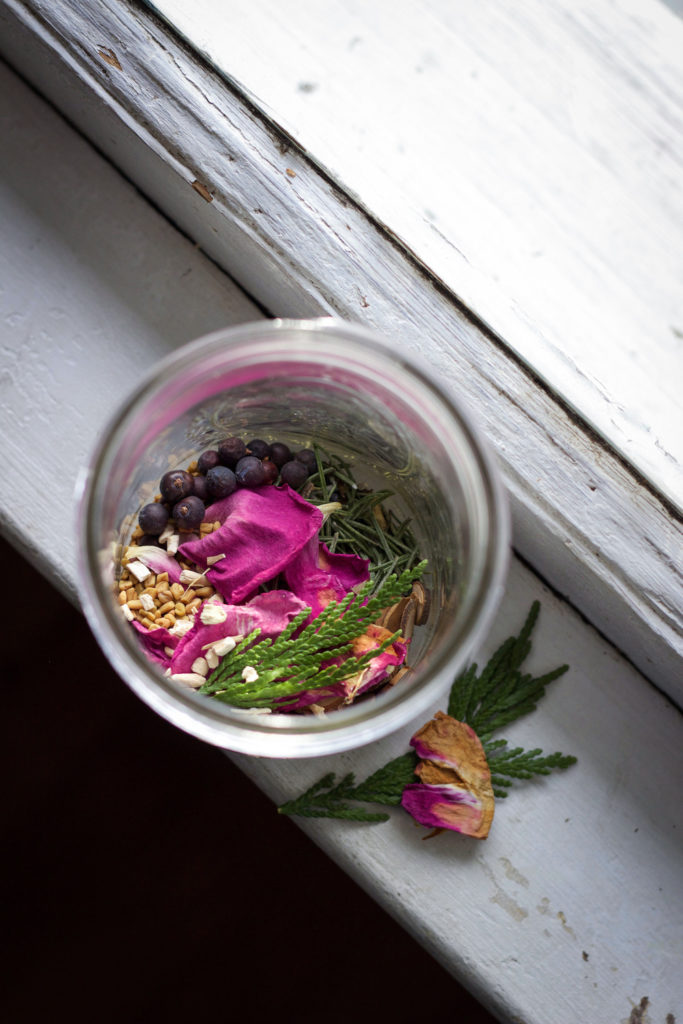
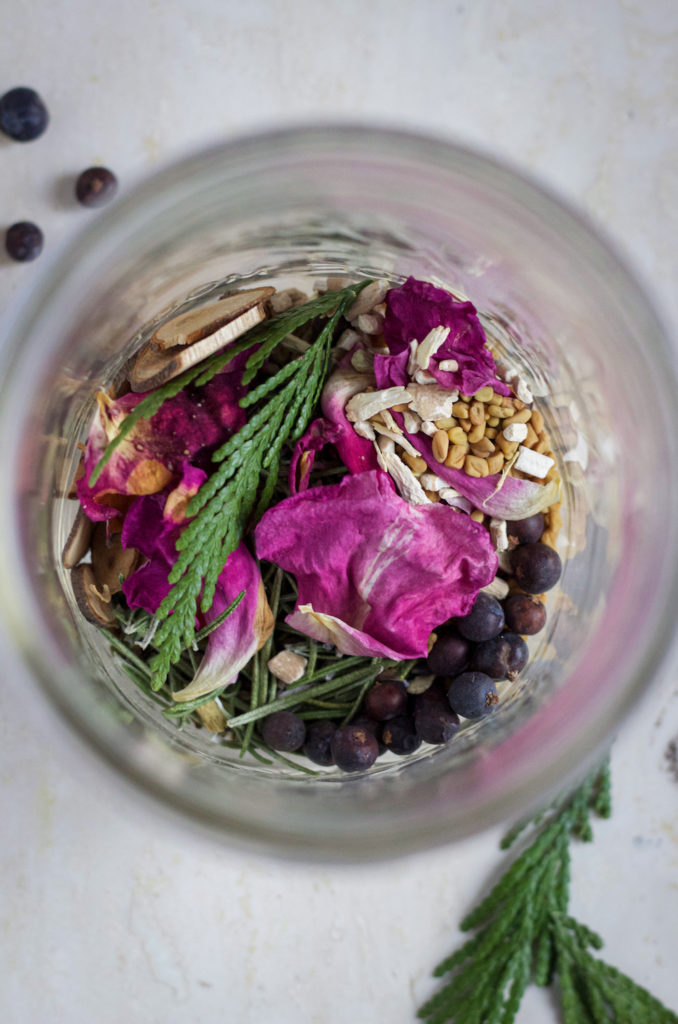
Go ahead: Add hard herb parts to an infusion (but know that it’s not fully physically medicinal)
In this post I’d like to bring up one of my many favorite practices of herbal tea blending, which is adding hard parts of herbs that would normally need to be decocted in an infusion.
Long ago I ditched the idea of keeping infusion herbs and decoction herbs separate.
YES I know that the decoction herbs are not as medicinal in a simple steep, as opposed to a ‘bring to a boil and simmer’ decoction method.
But in this case I’m adding them for holding space, not medicine. I say that they “hold space” because the harder herbs STILL convey their essence through the tastes that they impart to the tea.
You can taste them. They are there. There is medicine.
They are not as strong as a full decoction (I know I am repeating myself here), but adding hard herbs into an infusion allows me to experience them in a way I normally wouldn’t be able to if I stuck to the rules of separating only decoction/only infusion herbs.
I have incorporated them into my cup, into my day, into my life, into my healing practice. When I taste the White Peony Root I added to my infusion, I know deep within my gut (or lower abdomen, shall I say? Bai Shao/White Peony is specific for lower abdomen in Chinese Medicine) that Team Bai Shao is here with me right now. I feel their support, and I am integrating them into my being.
This is precisely why I say they are HOLDING SPACE.
Why don’t I just make a decoction if I want these herbs so badly?
Perhaps you are wondering why I wouldn’t just make a decoction. It is the best way to incorporate these harder herbs into our life, after all.
Or, I could do something I used to to a lot in my early herbal days: grind the harder herbs in a coffee grinder before adding them to an infusion, so they are more fully extracted for both flavor and medicinal action.
The short and sweet answer is: I am recovering from chronic debilitating Lyme and a mom of two little kids. I don’t have time or energy for that. It is a miracle that I even stand upright half the time.
Being disabled with Lyme has pushed my beliefs about herbal medicine to new territories. Sometimes I would really want to get up and use a remedy to help myself feel better, but since I couldn’t move, I would just think about the herb, or pray to it.
In a delusional pain episode, or a migraine stupor, I would imagine that I was partaking in the medicine of this herb somehow, someway. Often the medicine of the plant would show up and help me, even though I didn’t ingest it.
Expanding my herbal view
It is great that herbs show up to help me when I am practically not even in my body, floating in the underworld or imaginal realms.
But how does this transfer to normal reality, with more typical use of medicinal herbs?
I cannot say that if you simply think of an herb enough it will heal you. This is an out-of-touch blanket statement that is too generalized to be of any use.
But I definitely believe that we as Western herbalist are too hemmed in by convention. We don’t play with the herbs enough. We don’t try and re-try herbal experiments. We are as creative as we could be.
Thinking that the ONLY way to get medicine from a hard herb is a decoction is limited. If you can taste an herb, its medicine is engaging with you, without a doubt.
Adding hard herbs to infusions bring in new possibilities for herbal tea blending and formulations.
Ever-evolving, slow extracted roots
I steep my teas multiple times.
I also do not use a tea strainer! Yeah, I am kind of weird like that.
Not using a tea strainer allows me to easily add more hot water to the same tea again and again.
Of course, you can easily re-steep a tea if you want to use a tea strainer, too. It is just that much easier for me to keep it all in the same cup without transferring the herbs from a strainer back into a jar.
Here is the magic of re-steeping herbal tea blends with hard roots and berries: with each steep the flavor of these harder herbs unfold. Each steep hits a little deeper, gets a little more grounding, a little more adrenal nourishing. I find this particularly true with Licorice.
Tea sipping: a nervous system exercise
The other benefit of not using a tea strainer is that sipping carefully around herbs is an exercise for the Vagus and Phrenic nerves.
The Phrenic nerve is a cranial nerve that help regulate what is called the “suck, swallow, breath” reflexes, thusly called this because of its importance with newborns who are laying down important neural tracks. When you engage the Phrenic nerve, it is part of the pathway that fires the feel-good hormones and neurotransmitters associated with the bliss that is breastfeeding or sucking on a pacifier or bottle.
The Vagus nerve is the “cranial nerve darling” of the decade. It is so important and impactful into our whole being. I won’t even attempt to get into it in this post but give it a google search if you are interested. This is one overview of its importance in our healing and functionality.
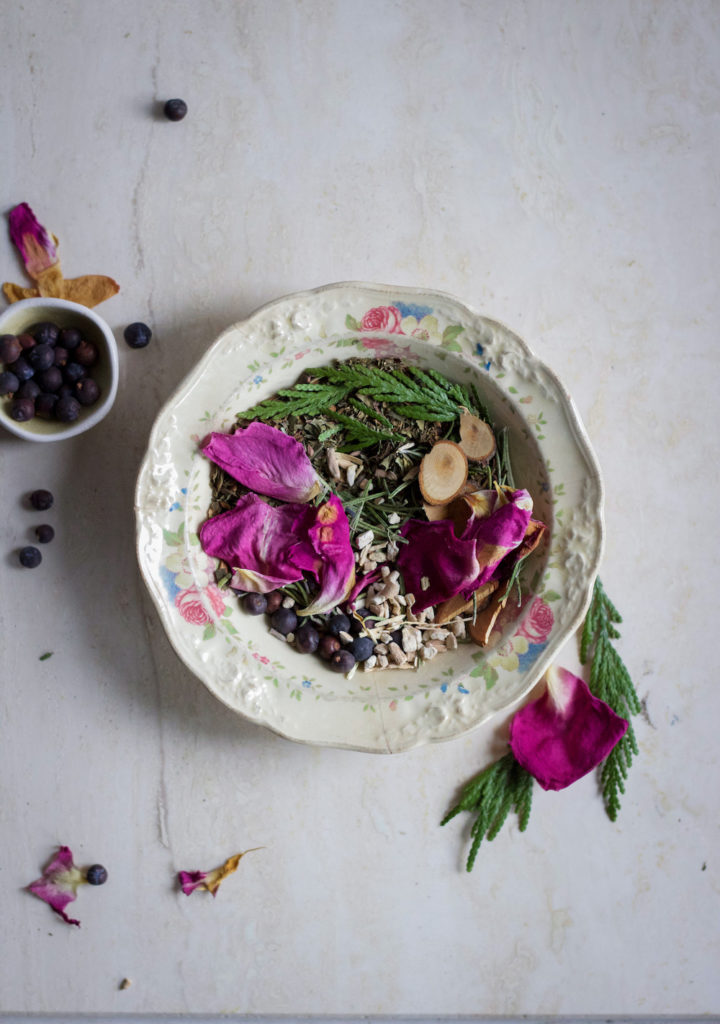
Cedar, Rose, and Rosemary Mentally Uplifting Tea Blend
This Cedar and Rose tea came about when I was feeling mentally sluggish and physically drained. Cold. Brick in head feeling. Wanting to curl up under a blanket (which I generally love, but I have two little kids at home so, you know…).
Rose – Cools and moves constricted Liver Qi to free up the Heart. Makes a good tea taste magical. Rose is a harmonizer of the Upper Jiao/Heart center, and a standby in almost all my tea blends, second only after Licorice. I also love Rose externally for burns and internally as a decadent Rose Elixir.
Cedar – Freshening, opening yet grounding. Cleansing to mental debris and stagnant states, like a breath of fresh air as it opens the airways.
Rosemary – Awakens and connects the brain and the senses with its moving, upwards directing pungency.
Spearmint – Invigorating breath of fresh air for your body, brain, being; the plant with the highest content of the antioxidant polyphenol rosemarinic acid. Also sweetly composed, acting on the gut.
Shatavri – Centering one deeply within themselves; steadily and deeply Yin nourishing via the Kidneys. Slightly sour and sweet to contain and hold, then strenghten.
Fenugreek – Nutty earth warming nutritive Yang tonic that abundantly gives and gives; supports digestive processes (and enzymatic production, I believe).
Juniper Berries – That richly sensual sour conifer flavor – mmmm…
Cinnamon Twig – A little more moving than Cinnamon Bark chips, circulating protective Qi up and out, guides this tea towards the Bladder and Lung meridians of the upper body, senses and back of the head.
Ginger and Licorice – Warm nurturing deliciousness getting richer with each steep, the licorice gets much sweeter and evolves from formula harmonizer and Spleen/Stomach guider into steady Kidney tonifier.

Happy Tea Blending
I dedicate this tea blend to you all and for our journey ahead.
Take good care of yourselves.
Best,
Celia
An embodiment guide for your journey
Sometimes it is hard for me to convey all the different sides of myself publicly. Like a true blue Gemini, I have varying areas of expertise and interest. It is hard for me to focus on just one thing.
Because to me, all the different things I do in the end are all focused on feeling into the body as a guide and the healing that imparts.
This goes for clinical herbalism, which I am very passionate about, and for spiritual medicine, intuition and even astrology.
I like to say that I am the most skilled and knowledgeable in herbal medicine since I have been studying and practicing it since 2002. But then I remember that I have been engaging with the spirit realm since I was 5, studying dreams and astrology since I was 7, and essentially a baby witch/healer that entire time 😉
So even the most physical aspects of my herbal practice is rooted in continually feeling and assessing how the medicine lands within the levels of my body. This then informs my ability for formulate for others.
Don’t get me wrong – I adore book learning and typical education as well.
But even going to grad school for Chinese medicine had me constantly assessing:
How does this make me feel?
What does my body need?
If you’d like to explore some of the myriad of ways to get into your body, and the main reasons why I think it is helpful to our healing and intuition to do so, check out my free Embodiment Skills 101 Guidebook.
Click here to have it delivered to you via email.
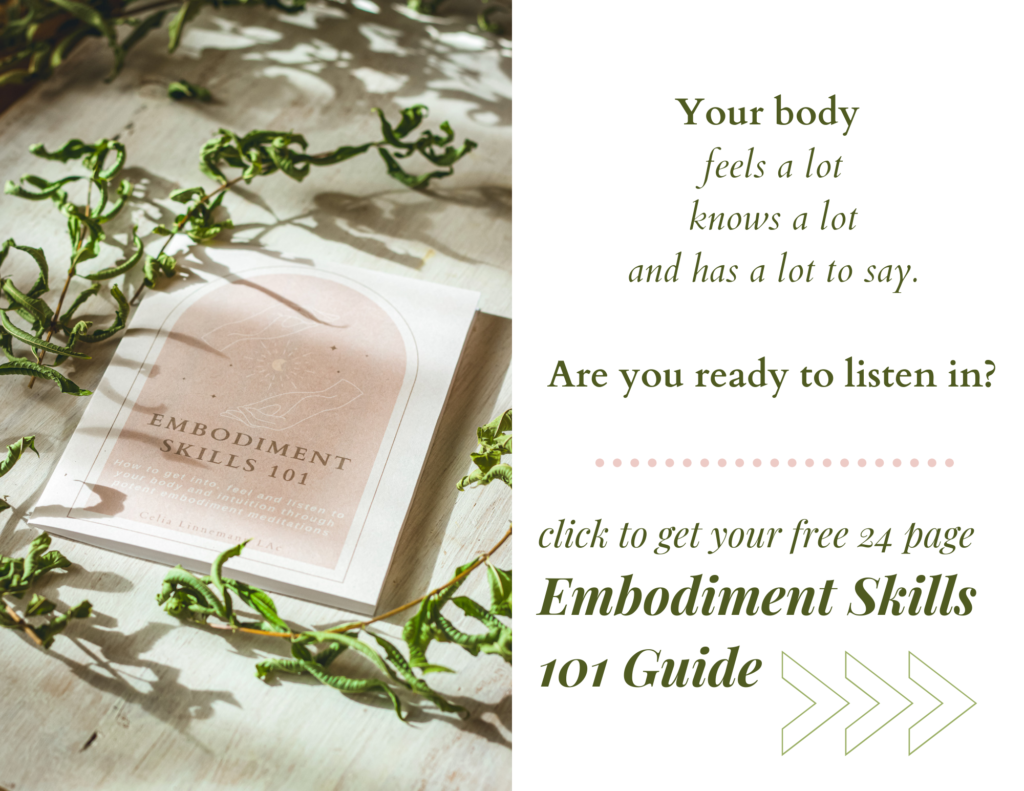
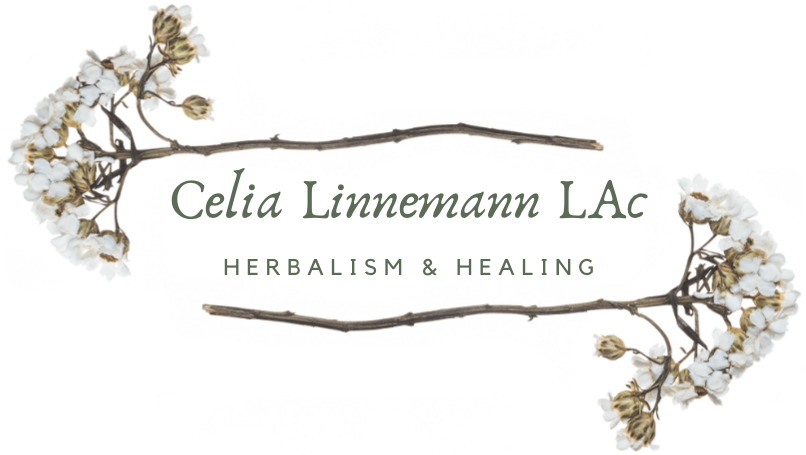





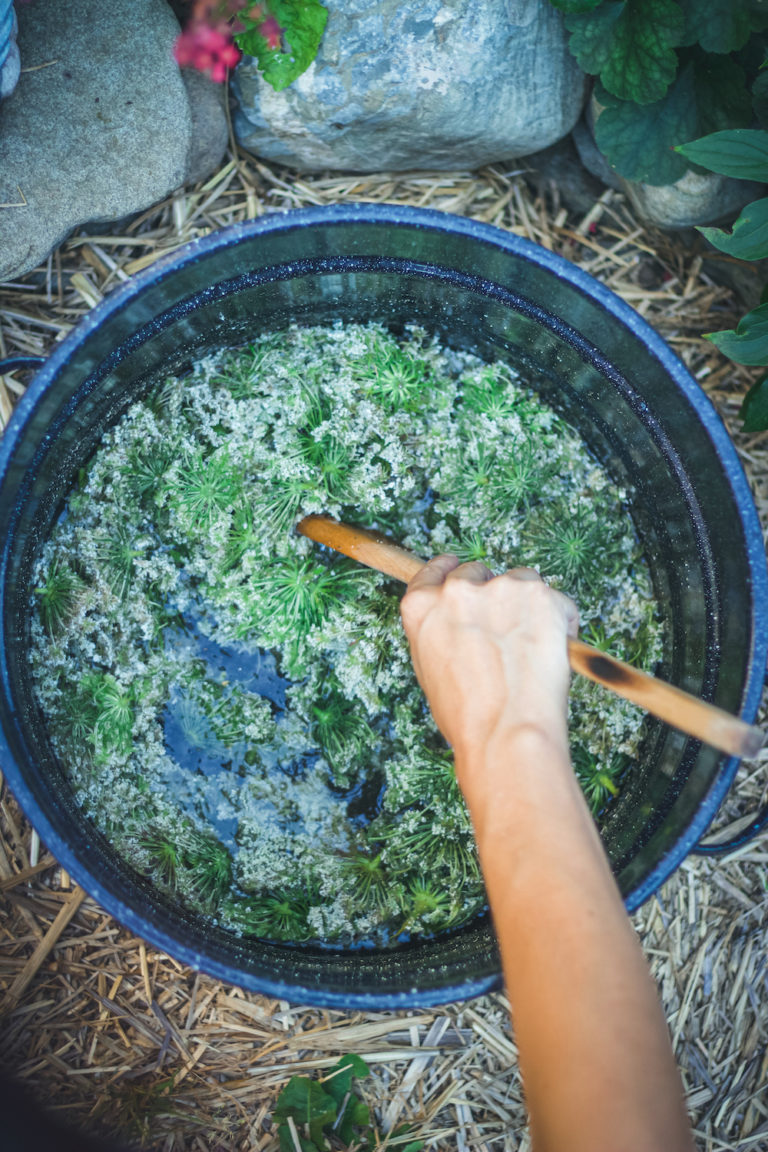


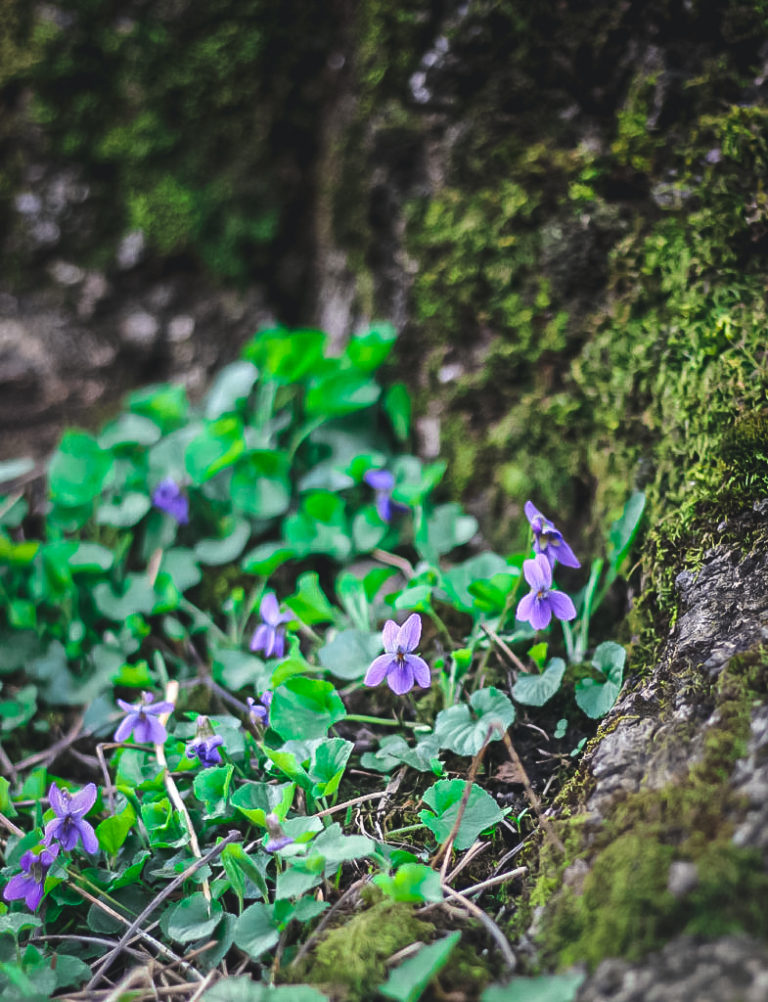


5 Comments